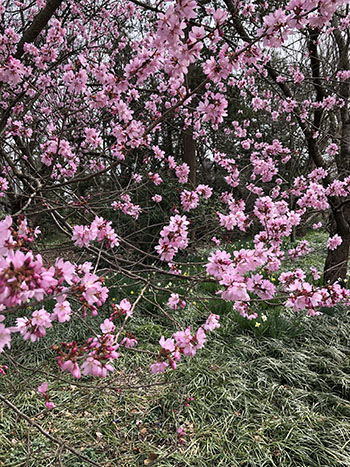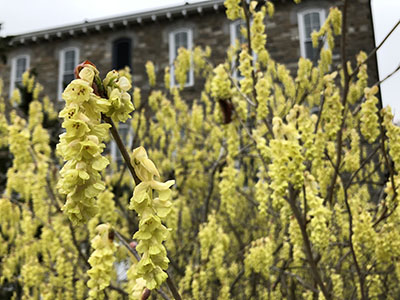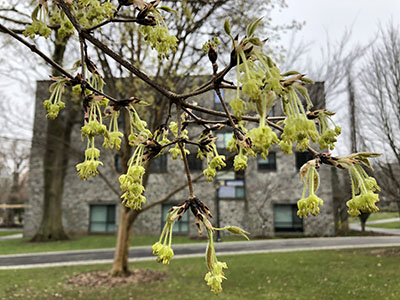
Plant of Week: March 23

Dream catchers were traditionally used as talismans to protect sleeping people, usually children, from bad dreams and nightmares. When hung above the bed in a place where the morning sunlight can hit it, the dream catcher attracts and catches all sorts of dreams and thoughts into its webs. Good dreams pass through and slide down the feathers to comfort the sleeper below. Bad dreams, however, are caught up in its protective net and destroyed, burned up in the light of day. I hope Prunus ‘Dream Catcher’ captures your bad garden dreams and slides the good dreams down its abundant pink flowers for your enjoyment.
Prunus ‘Dream Catcher’ is the result of an open-pollinated seedling selection of Prunus ‘Okame’. Released by the U.S. National Arboretum, ‘Dream Catcher’ offers numerous ornamental features. Medium pink, single flowers open about one week after the parent. Small, red drupes develop after flowering. Maturing to black, the fruit is relished by birds. Green, pest-tolerant leaves turn yellow-orange in fall. While ‘Okame’ has a more open and loose form, ‘Dream Catcher’ is more formal with an upright, vase-shaped habit reaching 25’ tall with a spread of 15’. Provide full sun and adequate water during dry spells. Photo credit: J. Coceano

Corylopsis sinensis var. calvescens is a lesser known member of the witchhazel family, Hamamelidaceae, that deserves, in my opinion, greater prevalence in the garden. Corylopsis are deciduous shrubs with simple, toothed leaves and nodding racemes of small, usually fragrant, bell-shaped pale yellow flowers in early spring. The pendant flowers are numerous and, when in full bloom, create a glowing effect.
Stems are great for forcing and make an unexpected addition to cut flower arrangements. Generally pest free; Japanese beetles have been observed feeding on the leaves. Site in a sheltered location with half day sun. Thin out larger stems every few years to promote vigor. Photo credit: J. Coceano

While the flowers of many trees are often overlooked for other features, the flowers of Acer triflorum were particularly eye-catching against the backdrop of Kohlberg Hall. Bearing a resemblance to Corylopsis in form and color, the flowers are borne in clusters of three, hence the species and common name, three-flowered maple. The shaggy peeling bark and glorious yellow, orange, and red fall foliage make this a great specimen tree. Smaller in stature compared to other maples, Acer triflorum matures to 20’ – 30’ in height and width. The overall size and appearance is akin to Acer griseum. Avoid major pruning in the spring as maples are “bleeders” and will lose lots of sap. Photo credit: J. Coceano





Sheila Weston
Posted at 15:32h, 03 AprilThanks Josh I love increasing my limited knowledge of trees, scrubs, and flowers.
Becky Robert
Posted at 15:34h, 03 AprilYour welcome. We try to help in little ways. Enjoy the weekend.
Sincerely,
Becky Robert
Scott Arboretum